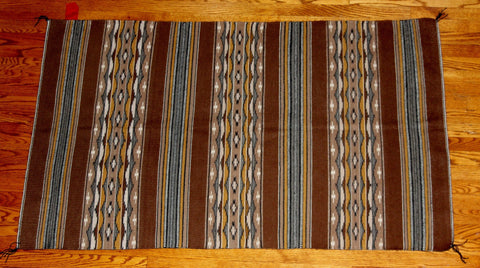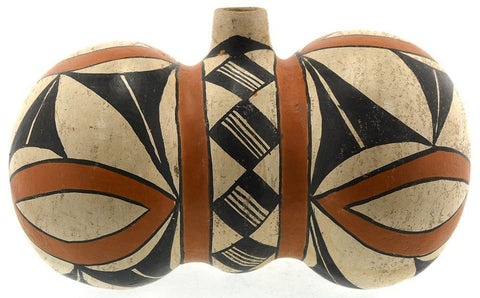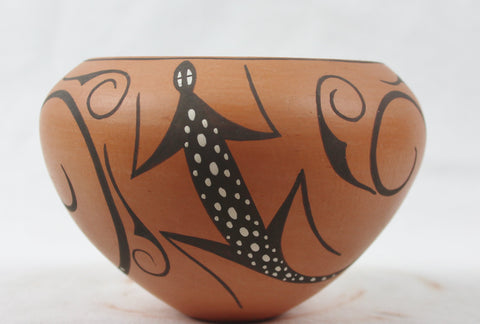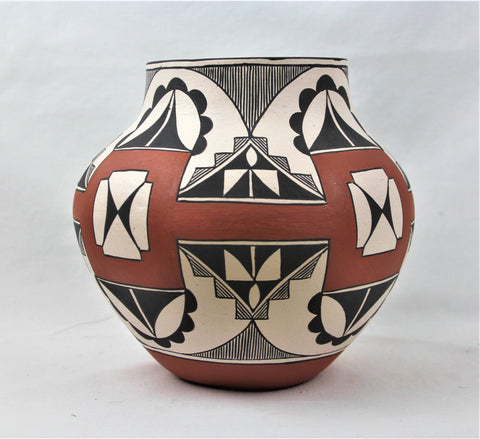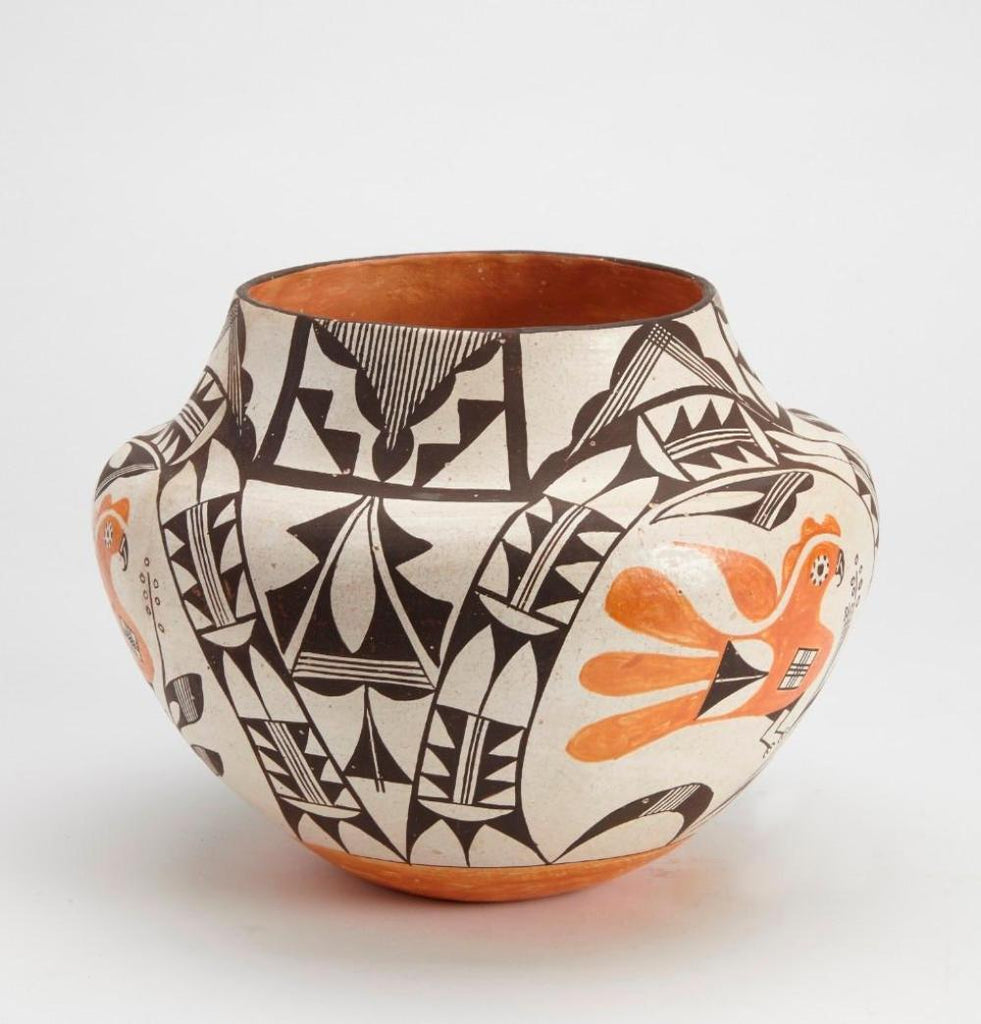
Native American, Vintage Acoma Poly Chrome Pottery Olla, by Marie Z Chino,CA 1950's, #1461 SOLD
$ 7,600.00
Native American, Vintage Acoma Poly Chrome Pottery Olla, by Marie Z Chino,CA 1950's, #1461
Description: #1461 Native American, Vintage Acoma Poly Chrome Pottery Olla, by Marie Z Chino,CA 1950's.
Dimensions: 8-1/2"h x 10"w
Condition: Excellent condition for age
Marie Zieu Chino (1907–1982) was a Native American potter from Acoma Pueblo, New Mexico. Marie and her friends Lucy M. Lewis and Jessie Garcia are recognized as the three most important Acoma potters during the 1950s.[1] Along with Juana Leno, they have been called "The Four Matriarchs" who "revived the ancient style of Acoma pottery."[2] The inspiration for many designs used on their pottery were found on old potsherds gathered to use for temper. Together they led the revival of ancient pottery forms including the Mimbres, Tularosa and other various cultures in the Anasazi region. This revival spread to other potters who also accepted the old styles, which led to new innovative designs and variations of style and form.
In 1922, Marie won her first award at the Santa Fe Indian Market at the age of fifteen. She went on to receive numerous awards for her pottery from 1970-1982. In 1998 the Southwestern Association for Indian Arts recognized Marie with a “Lifetime Achievement Award.”
Marie became particularly well known for her fine-line black-on-white pottery and vases with the step design. Her pots were distinctive in their complex geometric designs as well as the combination of life forms and abstract symbols. Some of her favorite designs include: Mimbres animals, Tularosa swirls, Acoma parrots, rainbows, bushes with berries, leaves, rain, clouds, lightning and fine-line snowflakes.
Marie was the matriarch of the Chino family of potters. She helped her children and grandchildren learn the fine art of pottery making and had many students. Marie had five daughters who were potters, "of whom Grace, Carrie and Rose achieved reputations as excellent potters."[3][4][5][6][7] Pottery by her daughter Vera Chino is held by the Holmes Museum of Anthropology.[8]
When Marie traveled to the Indian art shows or the Indian Market in Santa Fe, she often took her family with her. There they met people from around the world who loved to collect their pottery. This instilled a sense of pride and unity throughout the Chino family. Marie’s descendants have carried on the tradition of making fine Acoma pottery.
Marie's work is held by the Holmes Museum of Anthropology,[9] the Spurlock Museum,[10] and by the National Museum of the American Indian and the National Museum of Women in the Arts in Washington, D.C.,[11] (Source: Wikipedia)
---------
“Pueblo pottery is made using a coiled technique that came into northern Arizona and New Mexico from the south, some 1500 years ago. In the four-corners region of the US, nineteen pueblos and villages have historically produced pottery. Although each of these pueblos use similar traditional methods of coiling, shaping, finishing and firing, the pottery from each is distinctive.
Various clay's gathered from each pueblo’s local sources produce pottery colors that range from buff to earthy yellows, oranges, and reds, as well as black. Fired pots are sometimes left plain and other times decorated—most frequently with paint and occasionally with applique. Painted designs vary from pueblo to pueblo, yet share an ancient iconography based on abstract representations of clouds, rain, feathers, birds, plants, animals and other natural world features.
Tempering materials and paints, also from natural sources, contribute further to the distinctiveness of each pueblo’s pottery. Some paints are derived from plants, others from minerals. Before firing, potters in some pueblos apply a light colored slip to their pottery, which creates a bright background for painted designs or simply a lighter color plain ware vessel. Designs are painted on before firing, traditionally with a brush fashioned from yucca fiber.
Different combinations of paint color, clay color, and slips are characteristic of different pueblos. Among them are black on cream, black on buff, black on red, dark brown and dark red on white (as found in Zuni pottery), matte red on red, and poly chrome—a number of natural colors on one vessel (most typically associated with Hopi). Pueblo potters also produce un decorated polished black ware, black on black ware, and carved red and carved black wares.
Making pueblo pottery is a time-consuming effort that includes gathering and preparing the clay, building and shaping the coiled pot, gathering plants to make the colored dyes, constructing yucca brushes, and, often, making a clay slip. While some Pueblo artists fire in kilns, most still fire in the traditional way in an outside fire pit, covering their vessels with large potsherds and dried sheep dung. Pottery is left to bake for many hours, producing a high-fired result.
Today, Pueblo potters continue to honor this centuries-old tradition of hand-coiled pottery production, yet value the need for contemporary artistic expression as well. They continue to improve their style, methods and designs, often combining traditional and contemporary techniques to create striking new works of art.” (Source: Museum of Northern Arizona).
-----------
View the other items in my shop: http://www.etsy.com/shop/CulturalPatina?ref=shopsection_shophome_leftnavDescription:l world features.
Description: #1461 Native American, Vintage Acoma Poly Chrome Pottery Olla, by Marie Z Chino,CA 1950's.
Dimensions: 8-1/2"h x 10"w
Condition: Excellent condition for age
Marie Zieu Chino (1907–1982) was a Native American potter from Acoma Pueblo, New Mexico. Marie and her friends Lucy M. Lewis and Jessie Garcia are recognized as the three most important Acoma potters during the 1950s.[1] Along with Juana Leno, they have been called "The Four Matriarchs" who "revived the ancient style of Acoma pottery."[2] The inspiration for many designs used on their pottery were found on old potsherds gathered to use for temper. Together they led the revival of ancient pottery forms including the Mimbres, Tularosa and other various cultures in the Anasazi region. This revival spread to other potters who also accepted the old styles, which led to new innovative designs and variations of style and form.
In 1922, Marie won her first award at the Santa Fe Indian Market at the age of fifteen. She went on to receive numerous awards for her pottery from 1970-1982. In 1998 the Southwestern Association for Indian Arts recognized Marie with a “Lifetime Achievement Award.”
Marie became particularly well known for her fine-line black-on-white pottery and vases with the step design. Her pots were distinctive in their complex geometric designs as well as the combination of life forms and abstract symbols. Some of her favorite designs include: Mimbres animals, Tularosa swirls, Acoma parrots, rainbows, bushes with berries, leaves, rain, clouds, lightning and fine-line snowflakes.
Marie was the matriarch of the Chino family of potters. She helped her children and grandchildren learn the fine art of pottery making and had many students. Marie had five daughters who were potters, "of whom Grace, Carrie and Rose achieved reputations as excellent potters."[3][4][5][6][7] Pottery by her daughter Vera Chino is held by the Holmes Museum of Anthropology.[8]
When Marie traveled to the Indian art shows or the Indian Market in Santa Fe, she often took her family with her. There they met people from around the world who loved to collect their pottery. This instilled a sense of pride and unity throughout the Chino family. Marie’s descendants have carried on the tradition of making fine Acoma pottery.
Marie's work is held by the Holmes Museum of Anthropology,[9] the Spurlock Museum,[10] and by the National Museum of the American Indian and the National Museum of Women in the Arts in Washington, D.C.,[11] (Source: Wikipedia)
---------
“Pueblo pottery is made using a coiled technique that came into northern Arizona and New Mexico from the south, some 1500 years ago. In the four-corners region of the US, nineteen pueblos and villages have historically produced pottery. Although each of these pueblos use similar traditional methods of coiling, shaping, finishing and firing, the pottery from each is distinctive.
Various clay's gathered from each pueblo’s local sources produce pottery colors that range from buff to earthy yellows, oranges, and reds, as well as black. Fired pots are sometimes left plain and other times decorated—most frequently with paint and occasionally with applique. Painted designs vary from pueblo to pueblo, yet share an ancient iconography based on abstract representations of clouds, rain, feathers, birds, plants, animals and other natural world features.
Tempering materials and paints, also from natural sources, contribute further to the distinctiveness of each pueblo’s pottery. Some paints are derived from plants, others from minerals. Before firing, potters in some pueblos apply a light colored slip to their pottery, which creates a bright background for painted designs or simply a lighter color plain ware vessel. Designs are painted on before firing, traditionally with a brush fashioned from yucca fiber.
Different combinations of paint color, clay color, and slips are characteristic of different pueblos. Among them are black on cream, black on buff, black on red, dark brown and dark red on white (as found in Zuni pottery), matte red on red, and poly chrome—a number of natural colors on one vessel (most typically associated with Hopi). Pueblo potters also produce un decorated polished black ware, black on black ware, and carved red and carved black wares.
Making pueblo pottery is a time-consuming effort that includes gathering and preparing the clay, building and shaping the coiled pot, gathering plants to make the colored dyes, constructing yucca brushes, and, often, making a clay slip. While some Pueblo artists fire in kilns, most still fire in the traditional way in an outside fire pit, covering their vessels with large potsherds and dried sheep dung. Pottery is left to bake for many hours, producing a high-fired result.
Today, Pueblo potters continue to honor this centuries-old tradition of hand-coiled pottery production, yet value the need for contemporary artistic expression as well. They continue to improve their style, methods and designs, often combining traditional and contemporary techniques to create striking new works of art.” (Source: Museum of Northern Arizona).
-----------
View the other items in my shop: http://www.etsy.com/shop/CulturalPatina?ref=shopsection_shophome_leftnavDescription:l world features.
Related Products
Sold out
Sold out
Sold out







